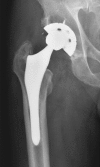THA with the ABG I prosthesis at 15 years. Excellent survival with minimal osteolysis
- PMID: 19730963
- PMCID: PMC2882022
- DOI: 10.1007/s11999-009-1066-5
THA with the ABG I prosthesis at 15 years. Excellent survival with minimal osteolysis
Abstract
Following recent reports of poor results with the hydroxyapatite-coated ABG I prosthesis, we report the survival of a series of 63 patients (69 hips) at a mean of 15 years (range, 13-17 years). In total, eight patients had revision procedures. The reason for revision was acetabular loosening in all cases. In only one case was there associated clinical and radiographic loosening of the femoral stem. The 15-year survival of the acetabular component was 86.9% (95% confidence interval, 71.7%-96.0%) and the 15-year survival of the femoral component was 98.6% (95% confidence interval, 88.8%-100.0%). Periacetabular osteolysis was seen in 10 of 59 (17%) surviving hips. In these hips the components remained well fixed owing to the remaining bone-component contact. There was no difference in the Oxford hip score between patients with well-fixed hips and evidence of osteolysis and patients with hips without evidence of osteolysis. Multivariate analysis failed to reveal any factors associated with the presence of osteolysis (gender, age at primary surgery, Oxford hip score, cup abduction, and acetabular polyethylene wear rates). The ABG I prosthesis continues to show excellent long-term results. Ongoing radiographic review is recommended to detect progressive osteolysis that otherwise remains clinically silent until failure.
Level of evidence: Level IV, Case series. See Guidelines for Authors for a complete description of levels of evidence.
Figures



Similar articles
-
Long-term results of the ABG-1 hydroxyapatite coated total hip arthroplasty: analysis of 111 cases with a minimum follow-up of 10 years.Orthop Traumatol Surg Res. 2009 Dec;95(8):579-87. doi: 10.1016/j.otsr.2009.10.001. Orthop Traumatol Surg Res. 2009. PMID: 19926546
-
Polyethylene Liner and Femoral Head Exchange in Total Hip Arthroplasty: Factors Associated with Long-Term Success and Failure.J Bone Joint Surg Am. 2019 Mar 6;101(5):421-428. doi: 10.2106/JBJS.18.00522. J Bone Joint Surg Am. 2019. PMID: 30845036
-
High revision rate of hydroxyapatite-coated ABG-I prosthesis.J Orthop Sci. 2009 Sep;14(5):543-7. doi: 10.1007/s00776-009-1367-2. Epub 2009 Oct 3. J Orthop Sci. 2009. PMID: 19802665
-
High wear rates and extensive osteolysis in 3 types of uncemented total hip arthroplasty: a review of the PCA, the Harris Galante and the Profile/Tri-Lock Plus arthroplasties with a minimum of 12 years median follow-up in 96 hips.Acta Orthop. 2006 Aug;77(4):575-84. doi: 10.1080/17453670610012638. Acta Orthop. 2006. PMID: 16929433 Review.
-
Osteolysis in cemented total hip arthroplasty involving the OptiPlug cement restrictor: more than an incident?Eur J Orthop Surg Traumatol. 2015 Jan;25(1):45-51. doi: 10.1007/s00590-013-1366-z. Epub 2013 Nov 28. Eur J Orthop Surg Traumatol. 2015. PMID: 24287638 Review.
Cited by
-
Total hip arthroplasty using a three-dimensional porous titanium acetabular cup: an examination of micromotion using subject-specific finite element analysis.BMC Musculoskelet Disord. 2021 Mar 26;22(1):308. doi: 10.1186/s12891-021-04174-z. BMC Musculoskelet Disord. 2021. PMID: 33771146 Free PMC article.
-
Stable fixation of short-stem femoral implants in patients 70 years and older.Clin Orthop Relat Res. 2012 Feb;470(2):442-9. doi: 10.1007/s11999-011-2063-z. Clin Orthop Relat Res. 2012. PMID: 21927967 Free PMC article.
-
Clinical results at 10 years of minimum follow-up with the ABG 2 hip arthroplasty, matched with ceramic-on-ceramic bearings.SICOT J. 2022;8:32. doi: 10.1051/sicotj/2022032. Epub 2022 Aug 15. SICOT J. 2022. PMID: 35969123 Free PMC article.
-
Total hip replacement with an uncemented Wagner cone stem for patients with congenital hip dysplasia.Int Orthop. 2011 Dec;35(12):1767-70. doi: 10.1007/s00264-011-1218-6. Epub 2011 Feb 12. Int Orthop. 2011. PMID: 21318569 Free PMC article.
-
The Results of Long-term Follow-up of Total Hip Arthroplasty Using Hydroxyapatite-coated Cups.Hip Pelvis. 2015 Dec;27(4):209-15. doi: 10.5371/hp.2015.27.4.209. Epub 2015 Dec 30. Hip Pelvis. 2015. PMID: 27536628 Free PMC article.
References
-
- Armitage P, Berry G. Statistical Methods in Medical Research. 3. Oxford, UK: Blackwell Scientific Publications; 1994.
-
- Dawson J, Fitzpatrick R, Carr A, Murray D. Questionnaire on the perceptions of patients about total hip replacement. J Bone Joint Surg Br. 1996;78:185–190. - PubMed
MeSH terms
Substances
LinkOut - more resources
Full Text Sources
Medical
Research Materials

